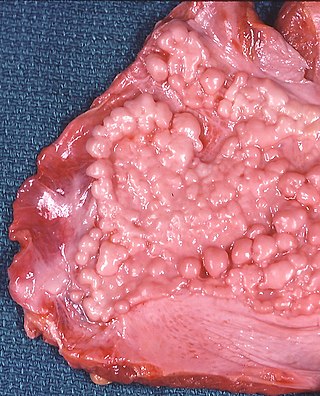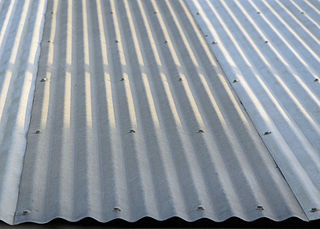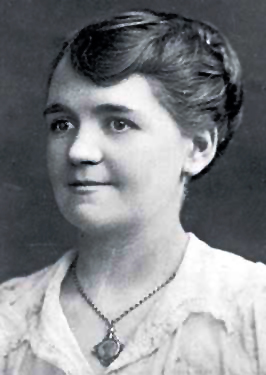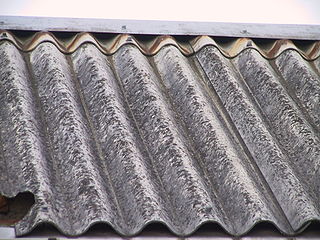
Mesothelioma is a type of cancer that develops from the thin layer of tissue that covers many of the internal organs. The area most commonly affected is the lining of the lungs and chest wall. Less commonly the lining of the abdomen and rarely the sac surrounding the heart, or the sac surrounding the testis may be affected. Signs and symptoms of mesothelioma may include shortness of breath due to fluid around the lung, a swollen abdomen, chest wall pain, cough, feeling tired, and weight loss. These symptoms typically come on slowly.

Asbestosis is long-term inflammation and scarring of the lungs due to asbestos fibers. Symptoms may include shortness of breath, cough, wheezing, and chest tightness. Complications may include lung cancer, mesothelioma, and pulmonary heart disease.

Ferodo is a British brake company based in Chapel-en-le-Frith in High Peak, Derbyshire.

Johns Manville is an American company based in Denver, Colorado, that manufactures insulation, roofing materials and engineered products. For much of the 20th century, the then-titled Johns-Manville Corporation was the global leader in the manufacture of asbestos-containing products, including asbestos pipe insulation, asbestos shingles, asbestos roofing materials and asbestos cement pipe.

Tremolite is a member of the amphibole group of silicate minerals with composition: Ca2(Mg5.0-4.5Fe2+0.0-0.5)Si8O22(OH)2. Tremolite forms by metamorphism of sediments rich in dolomite and quartz. Tremolite forms a series with actinolite and ferro-actinolite. Pure magnesium tremolite is creamy white, but the color grades to dark green with increasing iron content. It has a hardness on Mohs scale of 5 to 6. Nephrite, one of the two minerals of the gemstone jade, is a green variety of tremolite.
The mineral asbestos is subject to a wide range of laws and regulations that relate to its production and use, including mining, manufacturing, use and disposal. Injuries attributed to asbestos have resulted in both workers' compensation claims and injury litigation. Health problems attributed to asbestos include asbestosis, mesothelioma, lung cancer, and diffuse pleural thickening.

Asbestos cement, genericized as fibro, fibrolite, or AC sheet, is a composite building material consisting of cement and asbestos fibres pressed into thin rigid sheets and other shapes.

Fiber cement siding is a building material used to cover the exterior of a building in both commercial and domestic applications. Fiber cement is a composite material made of cement reinforced with cellulose fibers. Originally, asbestos was used as the reinforcing material but, due to safety concerns, that was replaced by cellulose in the 1980s. Fiber cement board may come pre-painted or pre-stained or can be done so after its installation.
Occupational lung diseases comprise a broad group of diseases, including occupational asthma, industrial bronchitis, chronic obstructive pulmonary disease (COPD), bronchiolitis obliterans, inhalation injury, interstitial lung diseases, infections, lung cancer and mesothelioma. These can be caused directly or due to immunological response to an exposure to a variety of dusts, chemicals, proteins or organisms. Occupational cases of interstitial lung disease may be misdiagnosed as COPD, idiopathic pulmonary fibrosis, or a myriad of other diseases; leading to a delay in identification of the causative agent.

Turner & Newall was a manufacturing business based in Manchester, United Kingdom. At its peak, it was a constituent of the FT 30 index of leading companies on the London Stock Exchange. As part of their business, the company was one of the first to industrialise asbestos, and its eventual demise in 2001 left an aftermath of asbestos litigation.

Asbestos is a naturally occurring fibrous silicate mineral. There are six types, all of which are composed of long and thin fibrous crystals, each fibre being composed of many microscopic "fibrils" that can be released into the atmosphere by abrasion and other processes. Inhalation of asbestos fibres can lead to various dangerous lung conditions, including mesothelioma, asbestosis, and lung cancer. As a result of these health effects, asbestos is considered a serious health and safety hazard.

Erionite is a naturally occurring fibrous mineral that belongs to a group of minerals called zeolites. It usually is found in volcanic ash that has been altered by weathering and ground water. Erionite forms brittle, wool-like fibrous masses in the hollows of rock formations and has an internal molecular structure similar to chabazite. Some properties of erionite are similar to the properties of asbestos; however, erionite is not currently regulated by the U.S. Environmental Protection Agency and there are no occupational exposure limits for erionite fibers. Erionite was first described by A.S. Eakle in 1898, as white woolly fibrous masses in cavities in rhyolite lava near Durkee, Oregon. It was originally thought to be another relatively rare zeolite named offretite, which is very similar to erionite in appearance and chemical composition.

Peritoneal mesothelioma is the name given to the cancer that attacks the lining of the abdomen. This type of cancer affects the lining that protects the contents of the abdomen and which also provides a lubricating fluid to enable the organs to move and work properly.

Fibre cement is a composite building and construction material, used mainly in roofing and facade products because of its strength and durability. One common use is in fiber cement siding on buildings.

Nellie Kershaw was an English textile worker from Rochdale, Lancashire. Her death due to pulmonary asbestosis was the first such case to be described in medical literature, and the first published account of disease attributed to occupational asbestos exposure. Before his publication of the case in the British Medical Journal, Dr William Edmund Cooke had already testified at Kershaw's inquest that "mineral particles in the lungs originated from asbestos and were, beyond reasonable doubt, the primary cause of the fibrosis of the lungs and therefore of death". Her employers, Turner Brothers Asbestos, accepted no liability for her injuries, paid no compensation to her bereaved family and refused to contribute towards funeral expenses as it "would create a precedent and admit responsibility". She was buried in an unmarked pauper's grave. The subsequent inquiries into her death led to the publication of the first Asbestos Industry Regulations in 1931.

Eternit is a registered trademark for a brand of fibre cement currently owned by the Belgian company Etex. Fibre is often applied in building and construction materials, mainly in roofing and facade products.
Devil's Dust is a two-part Australian television docu-drama mini-series on the ABC which first screened in 2012. Based on journalist Matt Peacock's 2009 book Killer Company, Devil's Dust was researched and developed by producer Stephen Corvini for over two years prior to the series' production. Through the factual case of Bernie Banton, it recounts the tragedy of many Australian workers and their families afflicted with asbestosis and mesothelioma in the twentieth-century asbestos mining and processing industries. Though the extreme health risks of exposure to asbestos dust had been documented for many years, manufacturer James Hardie persisted in large-scale use of the material, aided by inadequate regulation by state health agencies.

Asbestos-related diseases are disorders of the lung and pleura caused by the inhalation of asbestos fibres. Asbestos-related diseases include non-malignant disorders such as asbestosis, diffuse pleural thickening, pleural plaques, pleural effusion, rounded atelectasis and malignancies such as lung cancer and malignant mesothelioma.

All types of asbestos fibers are known to cause serious health hazards in humans. The most common diseases associated with chronic exposure to asbestos are asbestosis and mesothelioma.
Occupational hazards of fire debris cleanup are the hazards to health and safety of the personnel tasked with clearing the area of debris and combustion products after a conflagration. Once extinguished, fire debris cleanup poses several safety and health risks for workers. Employers responsible for fire debris cleanup and other work in areas damaged or destroyed by fire are generally obliged by occupational safety and health legislation of the relevant national or regional authority to identify and evaluate hazards, correct any unsafe or unhealthy conditions and provide any necessary training and instruction and personal protective equipment to employees to enable them to carry out the task without undue exposure to hazards. Many of the approaches to control risk in occupational settings can be applied to preventing injuries and disease. This type of work can be completed by general construction firms who may not be fully trained specifically for fire safety and on fire hazards.

















